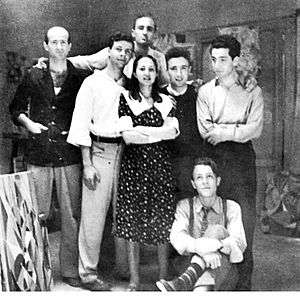Carla Accardi facts for kids
Quick facts for kids
Carla Accardi
|
|
|---|---|

Carla Accardi in her studio in Rome, 1976
|
|
| Born | 9 October 1924 |
| Died | 23 February 2014 (aged 89) |
| Nationality | Italian |
| Education | Accademia di Belle Arti di Palermo |
| Known for | Painter |
| Movement | Abstraction, Feminism |
Carla Accardi (born October 9, 1924 – died February 23, 2014) was an Italian abstract painter. She was famous for her unique style. Carla was a founding member of important Italian art groups. These included Forma (started in 1947) and Continuità (started in 1961). Her work is linked to art styles like Arte Informel and Arte Povera.
Contents
Carla Accardi's Life Story
Carla Accardi was born in Trapani, a city in Sicily, Italy. She studied art at the Accademia di Bella Arti in Palermo and Florence. In 1946, she moved to Rome. There, she helped start an art group called Forma in 1947.
Starting the Forma Art Group
Carla created Forma with other artists. These included Pietro Consagra, Ugo Attardi, Antonio Sanfilippo, Giulio Turcato, Piero Dorazio, Achille Perilli, and Mino Guerrini. Carla married Antonio Sanfilippo in 1949. The Forma group was inspired by an art style called futurism. Their first art show was in Rome in 1947. The Forma group also helped develop a style called movimento arte concreta. Carla's art became well known in France. An art critic named Michel Tapie was very interested in her work.

Carla Accardi's Art Work
Carla Accardi's first paintings were self-portraits. But moving to Rome made her try new things in her art. In 1946, she joined the Italian avant-garde movement. This was a group of artists who liked to experiment.
Exploring Colors and Materials
In the 1960s, Carla started painting in black and white. She focused on single colors (monochromy), shapes, and how colors looked together. She got ideas for these paintings after visiting Paris. There, she saw art by Alberto Magnelli and Hans Hartung. Their art inspired her to use black and white. These paintings were called her "Integrazione series."
Later in the 1960s, she began using bright, strong colors. Examples include Stella and II Stella (Star I and II). She also started using a clear plastic material called Sicofoil. Carla said this material was "luminous." It helped her art mix with the space around it. She used Sicofoil to make Tendas, which were like clear plastic tents. She decorated these tents with painted shapes. After working with black and white and Sicofoil, she used even more colors when she went back to painting on canvas.
Art and Social Change
In the late 1970s, Carla became involved in the women's rights movement. She worked with a critic named Carla Lonzi. Together, they started Rivolta femminile in 1970. This was one of Italy's first groups and publishing houses for women. Carla Accardi is seen as a very important artist in the Italian avant-garde. Her art also influenced the Arte Povera movement in the late 1960s. Carla Accardi had her first solo art show in the United States in 2001. It was at MoMA PS1 in New York.
Some of her well-known works include:
- Bianco nero su turchese (1960)
- Azzurroviolarancio (1962)
- Segni Rosa (1971)
- Per L'Infinito lo Scirocco (1987)
- Apparenti Tinte (1990)
- Viola Arancio (2005)
- Blu (2007)
Exhibitions
Carla Accardi's art was shown in many places around the world. She had many solo exhibitions, where only her work was featured. She also took part in many group exhibitions with other artists. Her art was displayed in major cities like Rome, Brussels, Paris, New York, and Shanghai.
See also
 In Spanish: Carla Accardi para niños
In Spanish: Carla Accardi para niños

